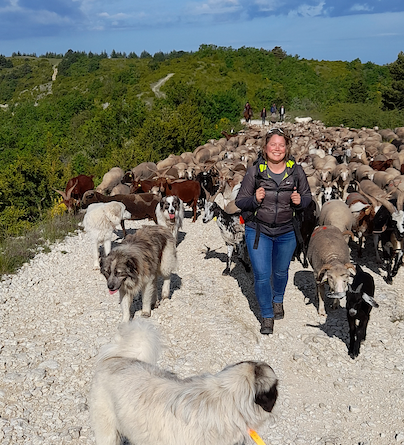Mots-clés : Organisation spatiale, mobilité, pastoralisme, évolution du paysage végétal
Principales responsabilités/diplômes
- 2024 Élue au comité d’administration de la Société Préhistorique Française : mission animation et lien avec la société. Paris, Président J.-D. Vigne
- 2023 Nommée au comité scientifique du Musée de Préhistoire des Gorges du Verdon Quinson, Dep. des Alpes de Haute-Provence, Dir. S. Jurietti
- 2020 Titre de Bergère-Vachère d’Alpage - CFPPA Reinach, Motte-Servolex
- 2018 Doctorat en Préhistoire « Gestion des espaces forestiers provençaux et ligures au Néolithique : approche anthracologique » - Co-encadrement C. Delhon & I. Théry-Parisot, Contrat doctoral, Université Côte d’Azur (UCA) - CEPAM
- 2010-2012 Master en Archéologie (spécialité Anthracologie & Néolithique) - LAMPEA-LA3M, Aix-Marseille Université
- Projet de recherche
Au travers de l’identification au microscope des essences ligneuses des charbons de bois archéologiques, je documente les modifications du couvert végétal du Mésolithique à l’âge du Fer, de part et d’autre des Alpes méridionales, afin de préciser les processus d’anthropisation du milieu. En associant les données anthracologiques et palynologiques disponibles pour la période et la région considérées, je reconnais dans ces données botaniques plus que de simples témoignages des forêts du passé mais des indicateurs de la vie pastorale. Je propose ainsi une synthèse régionale des dynamiques de végétation non avec l’angle de vue d’un observateur extérieur mais en cheminant entre ces paysages, à hauteur de vue des bergers qui les parcouraient.
Cette approche est adossée à des enquêtes de terrain sur la gestion des ressources végétales et les saisons de reproduction des ovins, dans différents systèmes d’élevages du sud-est de la France. Ma démarche aux interfaces entre les sociétés humaines, la végétation, les troupeaux et le territoire, basée à la fois sur une approche naturaliste et anthropologique, permet notamment de réfléchir aux choix d’implantation et de montrer que la question souvent débattue de la mobilité pastorale peut être abordée dans un cadre holistique, en considérant l’ensemble des activités qui se déroulent des basses jusqu’aux hautes altitudes.
Membre des programmes de recherche
- 2023-2024 Projet Franco-Italien PEPA (Patrimoine Environmental Culturel) - Dir. V. Buccio (SDA04)
- 2022-2026 ANR AUTUMN LAMBS: Autumnal lambing in the Mediterranean area (7e -3e mill.): the history of complex interactions between biology, paleoenvironments and technical systems - Dir. M. Balasse, MNHN.
- 2021-2026 PCR Occupations humaines sur le plateau de Méjannes le Clap et les gorges de la Cèze à la transition Néolithique final – début de l’âge du Bronze : Dynamique d’occupations et pratiques funéraires - Dir. M. Le Roy, Bournemouth University
- 2018-2023 PAstoralism, TransHumance in the Western Alps: Protohistoric to Medieval pastoralism in the Western Alps, the origins and development of long-distance transhumance (PATHWAy) - Dir. F. Mocci, P. Magniez, AMU ; K. Walsh, York University
- 2020-2023 AgroPastCN : Nourrir la terre, nourrir le troupeau : approche isotopique des cycles du carbone et de l’azote dans un système agro-pastoral Néolithique - Dir. C. Delhon, CEPAM
- 2018 CoproArchéo : Apport de la bioarchéologie des dépôts coprogènes à la connaissance du pastoralisme Néolithique - Dir. C. Delhon, CEPAM
- 2016-2023 GDR Chasséolab - Dir. V. Léa, TRACES et C. Georjon, INRAP
Extrait de la production scientifique (HAL)
Filtrez par type
Ou filtrez par année


